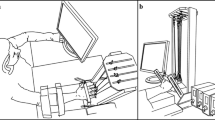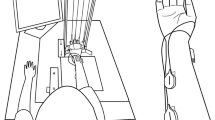Abstract
The fingers on a hand show interactions in force production tasks. The interfinger connection matrices (IFMs) quantify these interactions (Li et al. 2002; Zatsiorsky et al. 2002b; Danion et al. 2003). The goal of the present study was to explore the differences in the IFMs of individual subjects and, in particular, to establish a procedure that may be used in the future for diagnostic purposes. Subjects (n=20) pressed downward maximally with ten different combinations of the four fingers, index (I), middle (M), ring (R), and little (L): I, M, R, L, IM, MR, RL, IMR, MRL, and IMRL. Voluntary activation of a subset of the four fingers was accompanied by an involuntary force production by fingers that were not intentionally activated (enslaving). Interfinger connection matrices were computed for each subject by the artificial neural network. The similarities/dissimilarities (proximities) between the individual matrices were determined. This procedure was performed twice: (a) for nonnormalized IFMs whose elements represented the amount of force (in newtons) exerted by a finger i in response to a unit command to a finger j; and (b) for normalized IFMs, after dividing the elements of each IFM by the total force produced by the four fingers acting together (the elements of the matrix are in percents). The 20×20 matrix of the proximities was subjected to multidimensional scaling (MDS) to reduce the number of dimensions and identify the major ones. To interpret the meaning of the computed dimensions, they were regressed on a set of finger force parameters described in the text. For the nonnormalized IFMs an interpretable dimension was the strength of the subjects. For the normalized IFMs two dimensions were interpreted: (a) the location of the point of resultant force application along the mediolateral axis that is defined by the pattern of force sharing among the fingers and (b) the total contribution of the enslaved forces into the total finger force. We speculate that the similarity of typical everyday tasks across the population promotes the similarity of the IMFs reflecting optimal hand functioning over these tasks.
Similar content being viewed by others
Author information
Authors and Affiliations
Corresponding author
Additional information
Acknowledgements This study was partly supported by NIH grants NS-35032, AR-048563 and AG-18751. The support from the Whittaker Foundation to Dr. Z.M. Li is also acknowledged.
Rights and permissions
About this article
Cite this article
Gao, F., Li, S., Li, ZM. et al. Matrix analyses of interaction among fingers in static force production tasks. Biol. Cybern. 89, 407–414 (2003). https://doi.org/10.1007/s00422-003-0420-z
Received:
Accepted:
Published:
Issue Date:
DOI: https://doi.org/10.1007/s00422-003-0420-z




